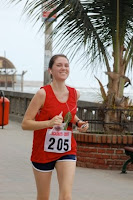Obviously, July 4th isn't as widely celebrated here in Peru as it is in the States. Although, I did catch a brief shoutout on a local radion station that said "felicidades a todos los gringos de gringlandia hoy" (congrats to all thos gringos from gringo land). That brought a smile to both Milene and my face as we were riding in a cramped
combi for the 2-hour ride to Pacasmayo, a town of about 20,000 situated right on the beach in northern Peru. The reason for our trip on July 4th, you may ask? Well, thanks to the ingenuity and hard work of Steve Cambridge, a small business peace corps volunteer in Peru, Pacasmayo was hosting its second annual international marathon and we were on our way to participate and volunteer. In fact, about 80 other Peace Corps volunteers showed up for the race weekend, and it was a unique opportunity to see our friends from far off pueblos in different parts of Peru. The marathon weekend was designed by Steve as a business project, meant to bring an influx of tourism to the town and benefit the many local restaurants, hotels, and artisans.
On Saturday we all arrived and in the afternoon attended meetings for both runners and volunteers. (Many Peace Corps volunteers chose to register as official runners, but others decided to help out with many of the logistics. There were also many Peruvians who showed up as volunteers.) This was followed by a raffle drawing where literally every single runner won some kind of prize donated by local businesses. I won a free lunch and Milene won a free hour at the internet cafe--needless to say, awesome. Later that night, Steve had a spagghetti and meatball dinner provided for all the runners. It was incredibly delicious (especially because the head chef was a volunteer named Josh who is a great cook from Texas), and reminded us of home on a very nostalgic day. After sufficient carbo-loading, we headed back to the hostel for an early sleep in preparation for the next day. On Sunday, runners gathered and did some stretching, heard a few opening remarks, including a rendition of the Star Spangled Banner by one our volunteers, and the race started promptly at 8:30. Milene was a runner in the half-marathon competition (21 kilometers or about 13 miles). I was signed up for the full marathon (42 kilometers, 26 miles), and trained for about two and a half months, but unfortunately had to stop due to a problem I developed in my right knee. The course itself was a challenging all-terrain course, with sand, rocks, dirt and pavement, as well as a final stretch of boardwalk. I borrowed a bicycle and went out to a few of the check points along the way to see how Milene was doing and provide her with some snacks. Milene completed the race in 2 hours and 23minutes, a great time and good enough for 6th place among the women's section. Afterwards, everyone commented how she was constantly smiling throughout the race and never seemed to look tired. Later that evening, we all gathered for a post-marathon party which included a 32 person rock-paper-scissor tournament.
The winner of the full marathon was a volunteer named Greg, who finished it in 3 hours and 22 minutes, an excellent time considering the terrain of the course (qualifying time for the Boston Marathon is 3:10). Greg lives in Arequipa at 4,000 meters where his training makes Pacasmayo (at sea level) seem like a walk in the park. We overheard a group of Peruvian runners who had traveled up from Lima saying that they thought he must have been a professional runner. In reality, it was only his second marathon ever, his first being at the First International Pacasmayo Marathon last year.
All in all the weekend was spectacular, and we will certainly be returning next year (hopefully injury-free). And all of you are invited to come participate with us! In fact, there were several runners who flew down from the States, Canada, Mexico and Europe to participate. Next year that could be you! If you'd like to check out more info, they have a website which is
www.maratoninternacionaldepacasmayo.com.
Looking back on the whole experience, I would say that the training itself was probably the most rewarding aspect for us both. Milene and I had never been runners before, and we mostly participated in team sports or gone to the gym as a means of exercise. In fact, before training, it was hard for us to even enjoy a few mile jog. But after training our bodies to get up at 6 every morning and go running, we began to feel a greater sense of well-being throughout the day. Our running trail itself passes along beautiful scenery and it felt great just to get out into nature and start our day off with some excercise. We soon came to think of 5 kilometer runs as "break" days, and regularly ran 10, 15 and even 20 kilometers. Our sneakers took a beating and are basically in the shoe morgue, so as soon as Milene's sister brings us some replacements at the end of this month, we'll be back in running action!












































